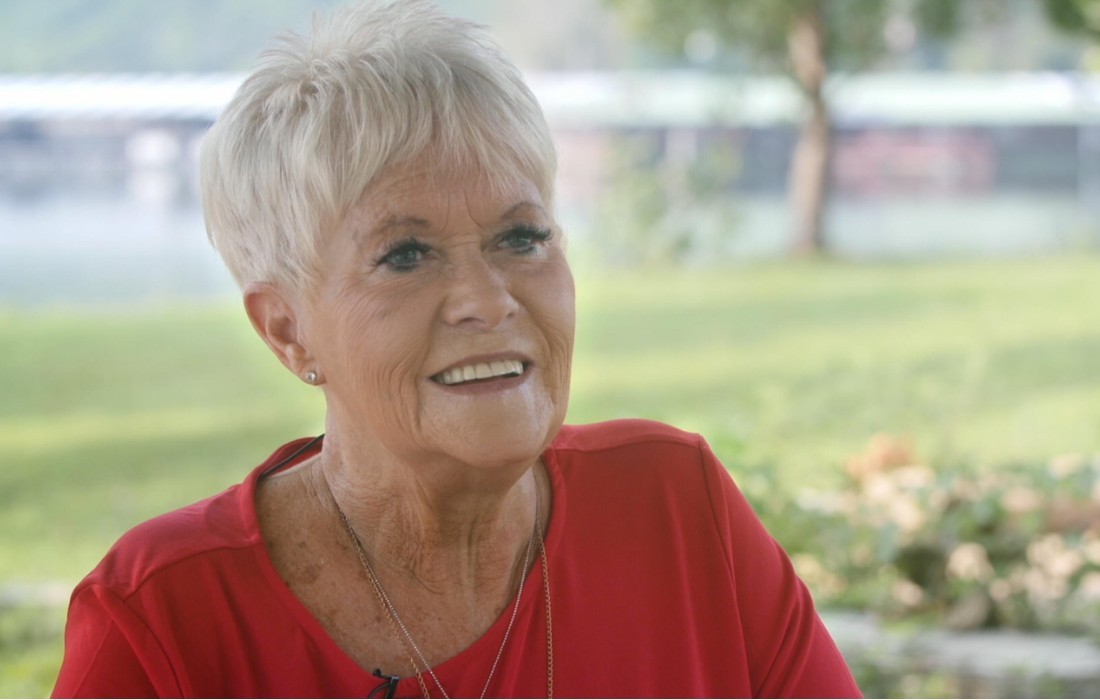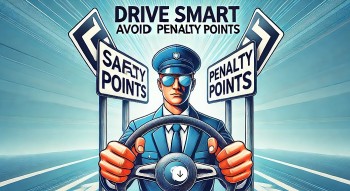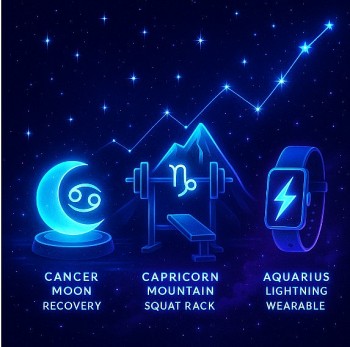The Hidden Homeless: Why Millions of Americans Are One Paycheck Away From Losing Everything
 Why the United States Is the Richest Country in the World but Still Has So Many Homeless People Why the United States Is the Richest Country in the World but Still Has So Many Homeless People |
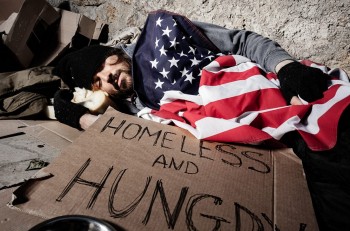 Can America Ever Solve Homelessness? A Look at the Only Cities That Are Actually Reducing It Can America Ever Solve Homelessness? A Look at the Only Cities That Are Actually Reducing It |
In the United States, homelessness is often associated with tents along sidewalks, crowded shelters and people sleeping on train benches. What most people rarely see is the much larger group living on the edge. These are Americans who have jobs, go to school, raise families and appear stable from the outside, yet sleep in cars, motels, garage spaces or on the couches of friends. They are known as the hidden homeless.
Hidden homelessness reveals a quieter, less visible crisis. Millions of Americans are not living in encampments or shelters, but they are not securely housed either. They live day to day, one unexpected expense away from losing the roof they have. Their stories challenge stereotypes about homelessness and raise important questions about the cost of living, the fragility of work and the reality of the American dream.
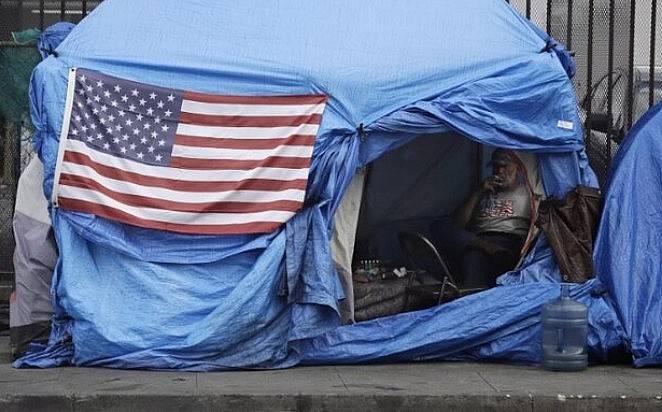 |
| US homelessness increases by 18% to record high |
1. Who Are the Hidden Homeless?
The hidden homeless are people without a stable or safe place to live but who do not fit the classic image of homelessness. They often avoid shelters and public spaces. Many continue working or attending school while trying to hide their situation.
Common forms of hidden homelessness include:
1.1 Sleeping in cars
Car lots, 24 hour gyms, supermarket parking areas and quiet residential streets are common nighttime spots. People try to stay unnoticed to avoid police encounters or neighborhood complaints.
Many working parents sleep in minivans with their kids. Workers in expensive cities sleep in cars because rent is unaffordable even with full time jobs.
1.2 Couch surfing
Couch surfing is a temporary safety net. Friends or relatives allow someone to stay for a few days or weeks. Rotating between multiple homes is common. It creates constant stress because the arrangement can end without warning.
1.3 Motel living
Weekly rate motels act as “emergency housing” for thousands. They cost more than an apartment in the long run, but require no deposit or credit check. Many families live in motels for months or even years.
1.4 Cramped shared housing
Some households pack three or four families into a single apartment. Everyone contributes a small amount of rent. Privacy disappears. Tempers run high. Evictions are frequent.
1.5 People hiding homelessness at work
Many hidden homeless individuals put on clean clothes in gym bathrooms, show up to work on time and never reveal their situation. Teachers, nurses, warehouse workers, baristas and even service members have been found sleeping in their cars.
They are unseen because they want to remain unseen. Shame and fear of judgment keep them quiet.
2. How Big Is the Hidden Homeless Population?
Counting hidden homelessness is difficult because it mostly takes place indoors, in vehicles or in private spaces. These situations do not appear in official government statistics. Researchers estimate the number is several times higher than the visible homeless population.
2.1 School data reveals the scale
American public schools track students who lack stable housing. Recent years show more than one million children classified as homeless each year. That number includes students living in motels, cars and doubled up housing.
Children rarely live alone on the streets. A child listed as homeless usually means an entire family is homeless.
2.2 The working homeless
A significant portion of homeless individuals have jobs. Rising numbers of delivery drivers, restaurant workers and even hospital employees live in their vehicles. For many, it is the only affordable option in cities where rent can exceed half their income.
2.3 “One paycheck away” data
Surveys show that nearly half of American households cannot cover a surprise $400 expense without borrowing money. When housing is unstable, a small crisis can trigger homelessness almost immediately.
3. Why So Many Americans Become Hidden Homeless
The rise of hidden homelessness is not about individual failure. It is a structural problem created by economic trends, housing shortages and the growing cost of everyday life.
3.1 Housing costs outpace incomes
In many cities, rent has doubled or tripled while wages stayed nearly flat. Even modest apartments require incomes far beyond what many workers earn. When rent consumes most of a paycheck, families fall into crisis quickly after job loss or illness.
3.2 High deposits and strict screening
To rent an apartment, tenants often need:
-
First month’s rent
-
Last month’s rent
-
Security deposits
-
Strong credit scores
-
Stable job histories
For low income workers or people recovering from past setbacks, these requirements block access to housing even when they can afford month to month rent.
3.3 Medical debt
Illness is one of the top drivers of bankruptcy in the United States. A hospital visit can wipe out savings. People who lose jobs due to health issues also lose their employer sponsored insurance. Medical debt cascades into housing instability.
3.4 Domestic violence
Many women and children fleeing abusive relationships become hidden homeless. They stay with friends or in motels while trying to stay safe. Going to shelters can feel risky or frightening.
3.5 Evictions
One missed rent payment can trigger eviction. Once someone has an eviction on their record, renting again becomes extremely hard. Many evicted families move into cars or couch surf to avoid shelters.
3.6 The gig economy
Gig workers often have unstable paychecks. When business slows, rent goes unpaid. Without benefits, savings or protections, gig workers are highly vulnerable to hidden homelessness.
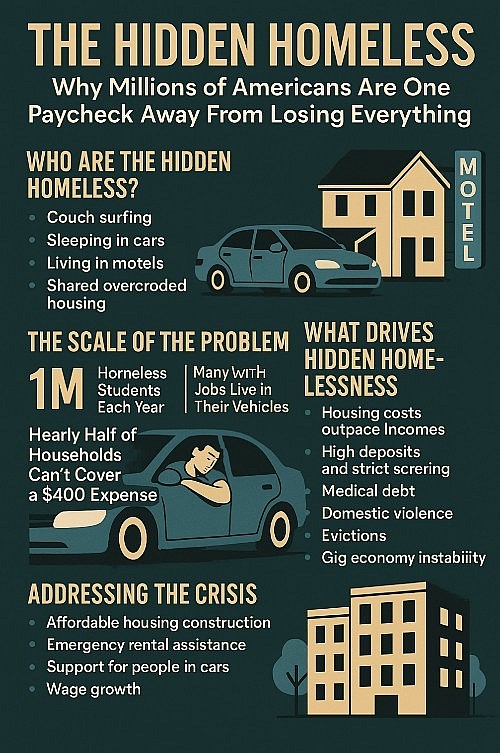 |
| The Hidden Homeless |
4. What Life Actually Looks Like for the Hidden Homeless
The daily reality of hidden homelessness varies widely. Some live in relatively stable but cramped spaces. Others live hour to hour with no idea where they will sleep next.
4.1 Living in cars
People sleeping in cars often adapt a routine:
-
Find a safe, quiet parking area
-
Cover windows for privacy
-
Store belongings in organized bags
-
Use gym memberships for showers
-
Keep fuel and insurance paid to avoid police towing
Even with a system in place, sleeping in a car is uncomfortable. It is hot in summer, cold in winter and constantly interrupted by fear of being discovered.
4.2 Couch surfing fatigue
At first, couch surfing may feel like a relief. But over time, people begin feeling like a burden. Hosts can become irritated. Privacy is nonexistent. Arguments break out. People move again and again, which disrupts work, school and mental health.
4.3 Motel living
Motels provide temporary safety but are financially draining. Weekly rates are much higher than standard rent. Families get stuck in this cycle because they cannot save enough to afford a deposit on an apartment.
Children in motel rooms do homework on beds or floors. Parents work overtime trying to save money. Stability is always out of reach.
4.4 Shame and silence
Many hidden homeless people do not tell friends or coworkers about their situation. They fear judgment, job consequences or losing custody of their children. This silence makes it harder to ask for help.
5. The Emotional Cost of Hidden Homelessness
Beyond the economic realities, hidden homelessness takes a heavy emotional and psychological toll.
5.1 Constant stress
People worry about being discovered, losing their temporary shelter or being unable to keep their kids housed.
5.2 Exhaustion
Sleeping in cars or on floors leads to chronic fatigue. Many still work long shifts while barely sleeping.
5.3 Anxiety and depression
The pressure of instability, the shame of hiding the situation and the fear of losing children or employment contribute to mental health struggles.
5.4 Impact on children
Children in hidden homelessness often change schools frequently, fall behind academically and experience emotional distress. They grow up feeling unsafe and insecure.
6. Why Hidden Homelessness Is Growing Faster Than Visible Homelessness
Visible homelessness gets more attention because it is seen on sidewalks and in parks. Hidden homelessness, however, is growing faster. Several forces drive this trend.
6.1 Working poor families cannot afford rent
Even two income households struggle in high cost cities. Families choose cars or motel rooms to stay together rather than enter shelters.
6.2 People avoid shelters
Shelters have limited beds, strict rules, curfews or safety concerns. Many prefer unstable alternatives to maintain autonomy.
6.3 Evictions happen quickly
After a single missed payment, eviction courts move fast. People lose housing long before they can secure alternative options.
6.4 Housing supply shortages
There simply are not enough affordable homes. Families fall through the cracks.
7. How Close Is the Average American to Hidden Homelessness?
Surprisingly close. Surveys show:
-
Almost half of Americans cannot cover a $400 emergency
-
One in four renters spend over half their income on rent
-
Many households have no savings at all
-
Medical bills are a leading cause of financial collapse
This means millions of Americans are doing well until the day they are not. Hidden homelessness exposes how fragile the line is between survival and crisis.
8. What Would It Take to Reduce Hidden Homelessness?
Addressing hidden homelessness requires solutions that match the scale of the problem.
8.1 Affordable housing construction
More affordable units are essential. Without supply, every other solution is limited.
8.2 Emergency rental assistance
Small grants can prevent evictions. Stopping homelessness before it begins is cheaper and more effective than responding afterwards.
8.3 Support for people living in cars
Safe parking programs provide secure lots, bathrooms and case management to help people transition to stable housing.
8.4 Reforming deposit and credit requirements
Many working families can afford monthly rent but not huge upfront costs. Lower deposits and alternative screening methods would open doors.
8.5 Wage growth
Rent rises while wages stagnate. Raising incomes is necessary for long term stability.
8.6 Health care reform
Reducing medical debt would prevent thousands from falling into homelessness every year.
9. Why the Hidden Homeless Should Not Be Ignored
Ignoring hidden homelessness does not make it smaller. It makes it more dangerous.
9.1 It affects millions, not thousands
Hidden homelessness is far larger than visible homelessness. It touches families, students and full time workers.
9.2 It leads to chronic homelessness
People without stable housing eventually fall deeper into the crisis if no intervention occurs.
9.3 It disrupts work and education
Employees who sleep in cars struggle to stay consistent. Children who move constantly fall behind. These issues create long term economic consequences.
9.4 It reveals deeper problems in the system
Hidden homelessness is not a fringe problem. It is evidence that the housing system is not working for a significant portion of the population.
10. Final Thoughts: The Crisis We Don’t See but Cannot Ignore
The hidden homeless are not distant strangers. They are coworkers, parents, students, neighbors and friends. They are people who laugh at jokes, attend office meetings, pick up their kids from school and then spend the night in a car or a motel room they cannot afford for another week.
Their crisis is invisible by design. They work hard to hide it. Society looks away because it is easier to focus on visible encampments than to acknowledge that millions are on the edge.
But hidden homelessness is the real heartbeat of America’s housing crisis. It shows how precarious life has become for ordinary people. It shows how quickly stability can collapse in a country where wages lag behind costs and safety nets have holes.
Solving homelessness begins with understanding that people do not fall all at once. They slide. One medical bill. One layoff. One rent hike. And suddenly, the car becomes the bedroom, the motel becomes home and the couch becomes the only place to sleep.
The hidden homeless deserve to be seen, heard and supported. Their story is not just about poverty. It is about resilience, survival and the urgent need for a system that gives people a chance to rebuild, not just to endure.
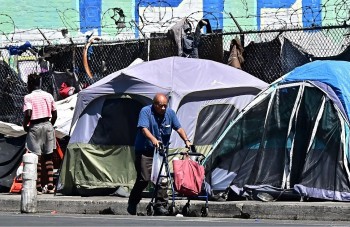 How Many Homeless People Are There in the U.S? Up 18.1% with Over 771,800 How Many Homeless People Are There in the U.S? Up 18.1% with Over 771,800 Homelessness in the United States has reached a staggering new high in 2024, with over 771,800 individuals living without stable housing. |
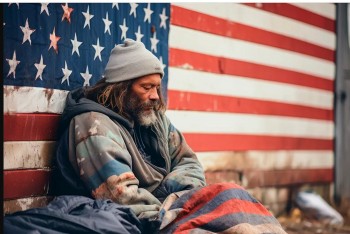 Breaking down Homelessness: Numbers, Lives, and Solutions Breaking down Homelessness: Numbers, Lives, and Solutions Homelessness in the United States is not just a personal struggle; it ripples through families, communities, and the nation’s economy. |
 Who is Jamar Banks? A Homeless Man Wanted in 2 New York Subway Stabbings Who is Jamar Banks? A Homeless Man Wanted in 2 New York Subway Stabbings NYPD officers arrested a homeless man on Sunday who was wanted for stabbing two individuals in separate incidents on the Manhattan subway system, including an ... |
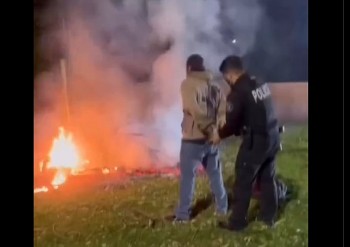 Who Is Jose Carranza-Escobar? The Third Suspected Arsonist In Los Angeles Fire Who Is Jose Carranza-Escobar? The Third Suspected Arsonist In Los Angeles Fire After a brush fire started in Pioneer Park, Azusa, California, police have arrested a man on suspicion of arson. He is a homeless man. The ... |









